A Royal Undertaking: Preparing the Costumes for Visitors to Versailles
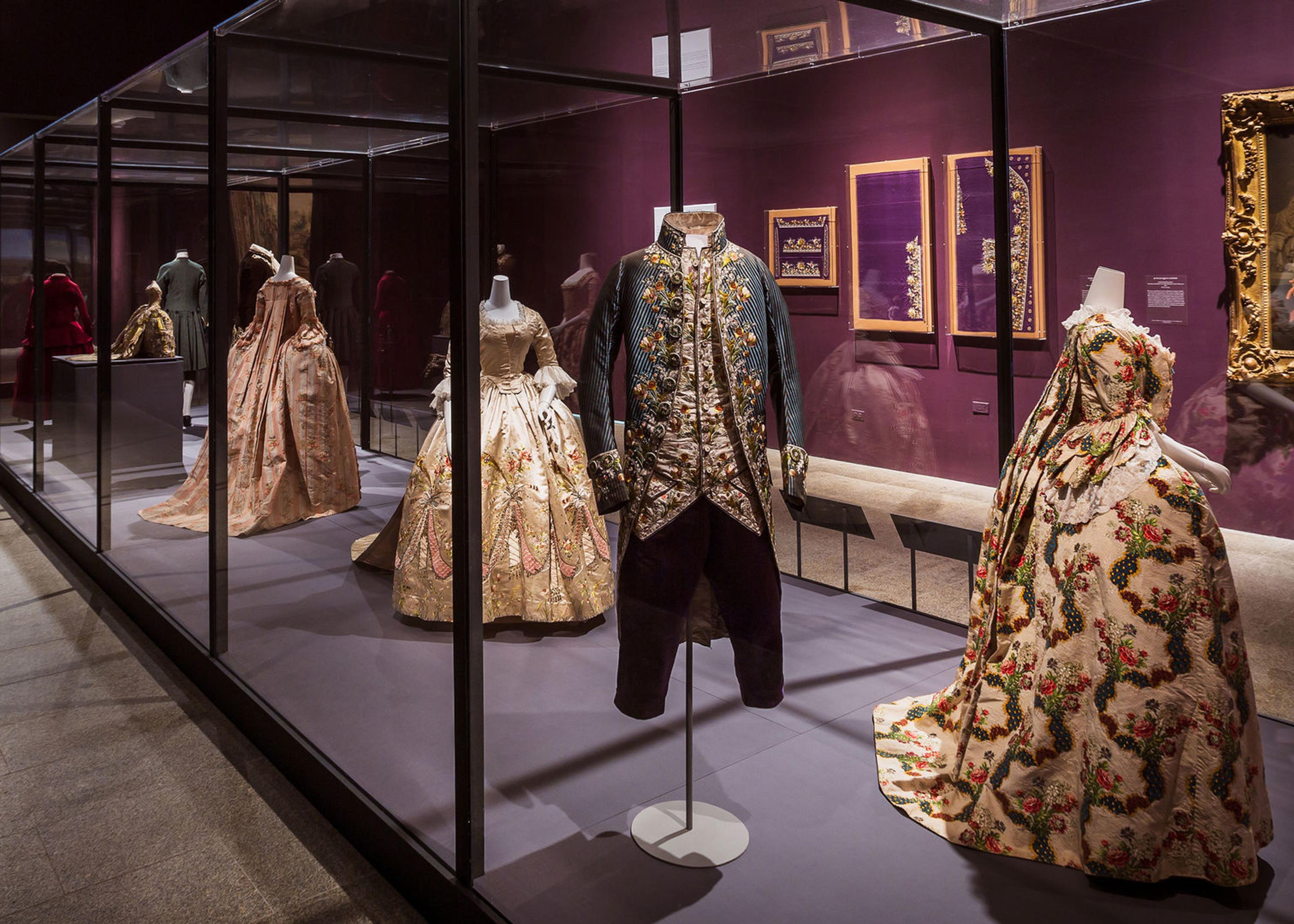
The "Getting Dressed for Court" gallery of Visitors to Versailles. Center: Suit (habit à la française), 1780s. French. Embroidered silk (modern breeches); length at CB (coat): 44 11/16 in. (113.5 cm); length at CF (waistcoat): 28 3/4 in. (73 cm). Nordiska Museet, Stockholm (NM.0154745A–C)
The exhibition Visitors to Versailles, a collaboration between the Palace of Versailles and The Met, includes rare and glorious examples of the finest court dress from eighteenth-century Europe; indeed, the exquisiteness of Versailles was matched only by the sumptuous finery of palace visitors in their silken and gilt ensembles. But while the exhibition visitors might swoon at the evocative costumes promenading through the galleries, they might not be familiar with the complex, behind-the-scenes efforts of the Costume Institute installation and conservation teams to prepare the garments for display.
Several of the costumes on display come from the Costume Institute's own exceptional holdings. Two objects, the British man's traveling suit and the tricorne hat, were included in the exhibition when it was held at Versailles earlier this year, while others, like two stunning pink dresses and a richly embroidered man's court suit, can only be seen in The Met's staging of the exhibition.
Prior to exhibiting any fashionable ensemble, the Costume Institute's conservators carefully examine and treat the objects so that they can be displayed safely and beautifully. The most intensive treatment for this exhibition was executed by Costume Institute Conservation Fellow Marina Hays, whose fellowship research examined conservation methods for eighteenth-century dresses and thus aligned perfectly with the objects to be exhibited. Marina studied, conserved, and dressed the two Costume Institute dresses in the show: both the more formal robe à la française and the less formal robe à l'anglaise.
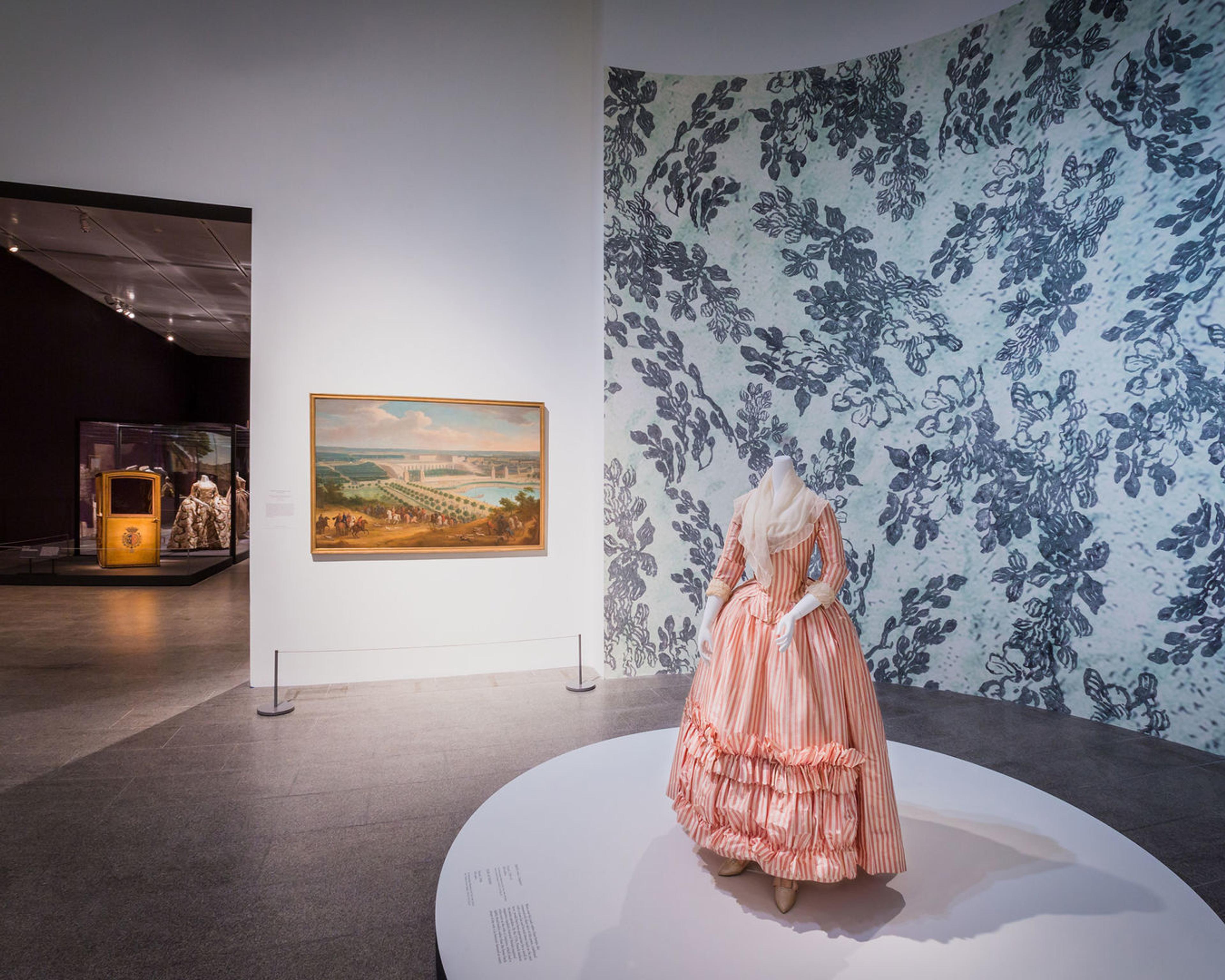
Installation view of Visitors to Versailles. Right: Robe à l'anglaise, 1785–87. French. Silk. The Metropolitan Museum of Art, New York, Purchase, Irene Lewisohn Bequest, 1966 (C.I.66.39a, b). Visible at left: Robe à la française, 1775–1800. French. Silk. The Metropolitan Museum of Art, New York, Purchase, Irene Lewisohn Bequest, 1961 (C.I.61.13.1a, b)
The conservators were particularly curious about the types of dye that had been used to create the dresses' brilliant pink colors. Nobuko Shibayama, Research Scientist in the Department of Scientific Research, analyzed the dye for both dresses and found that the robe à la française had been dyed with safflower, which means the dress likely used to be an even brighter pink. The striped robe à l'anglaise had been dyed with orchil, a dye that comes from lichen. The pink stripes had possibly once been a more lavender color, but shifted over time to appear pinker. These scientific findings also showed that the natural dyes in both garments are very sensitive to light, which allowed the Costume Institute's conservators to recommend, with confidence, very low light levels within the galleries to prevent further fading.
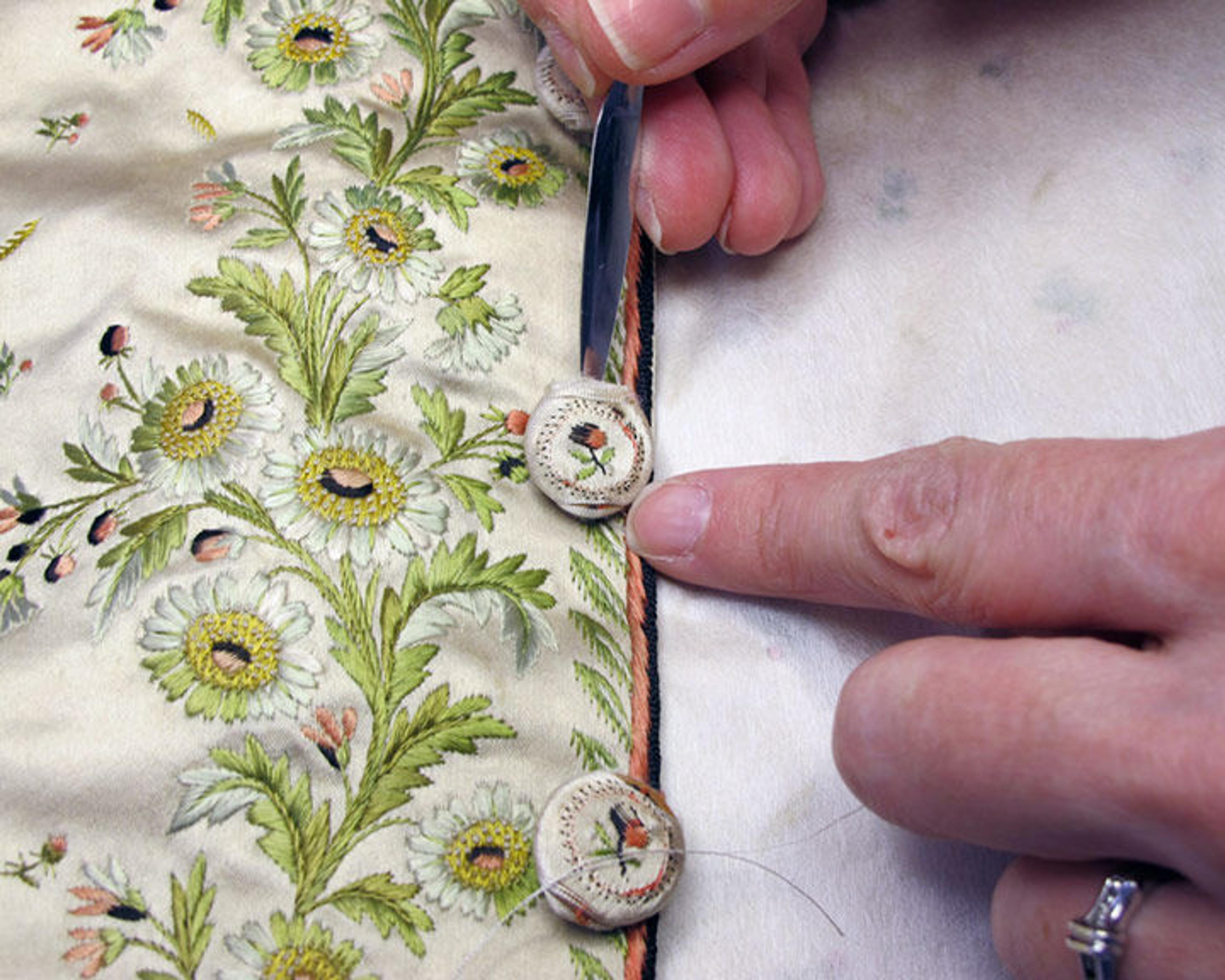
The silk-covered buttons of the waistcoat of the man's habit à la française received treatment before it could be safely dressed and displayed. Photo by Cassandra Gero
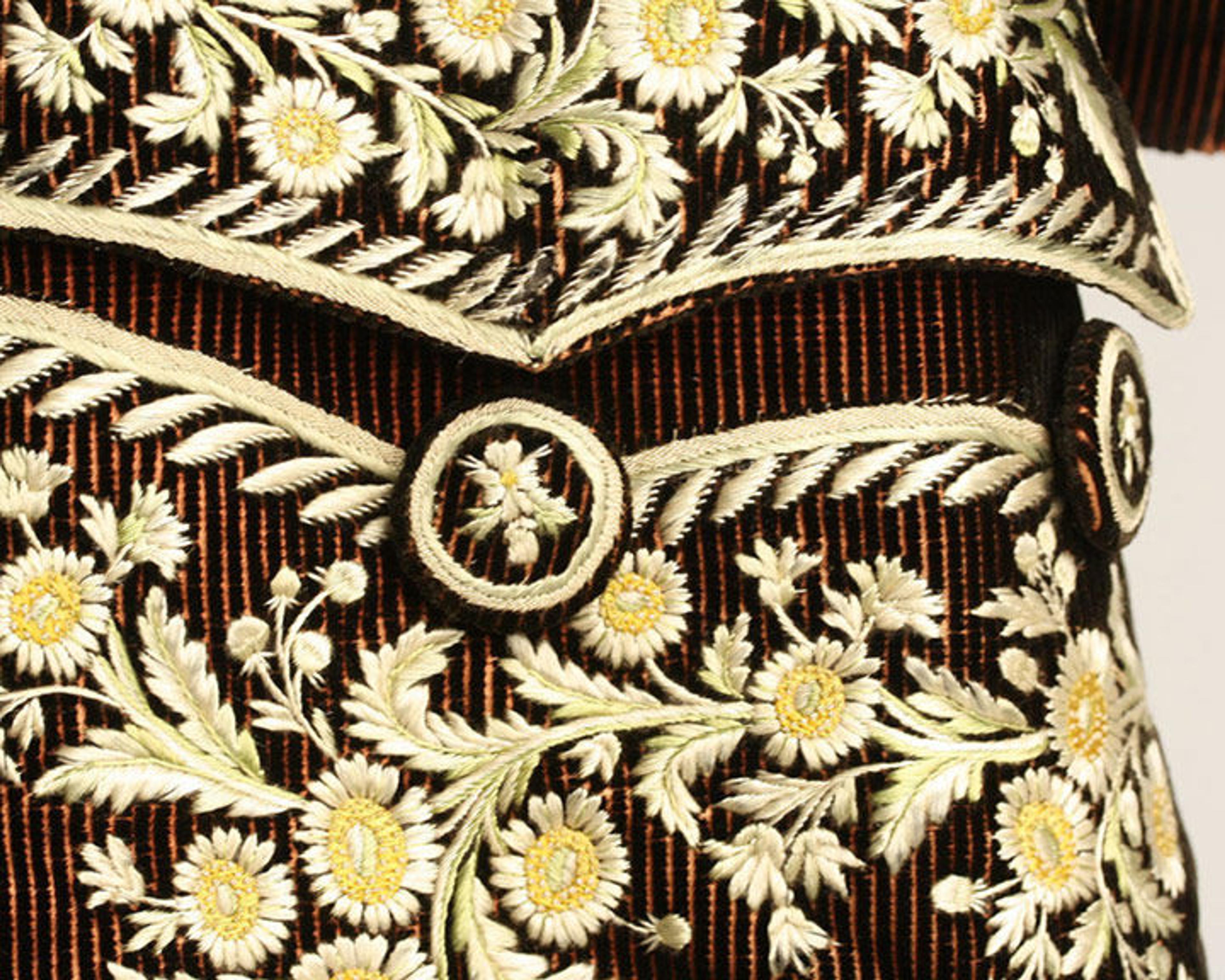
Court suit (detail), 1774–93. French. Silk. The Metropolitan Museum of Art, New York, Purchase, Rogers Fund, 1932 (32.40a–c)
There were areas in the man's court suit that needed to be stabilized before it could be dressed and displayed. Although the suit reads as brown, it is a voided silk velvet consisting of red ground fabric (which has faded to pink in areas) with fine stripes of black pile. The silk-velvet fabric at the shoulder required some stitch repairs, as did the lining. The buttons of the waistcoat (a.k.a. vest) also needed some love, not only to disguise existing distracting damage, but also to prevent further abrasion and loss of fibers to the delicate covered buttons. Silk underlays were used to fill in the losses, and a fine net overlay was laid over the top for protection.
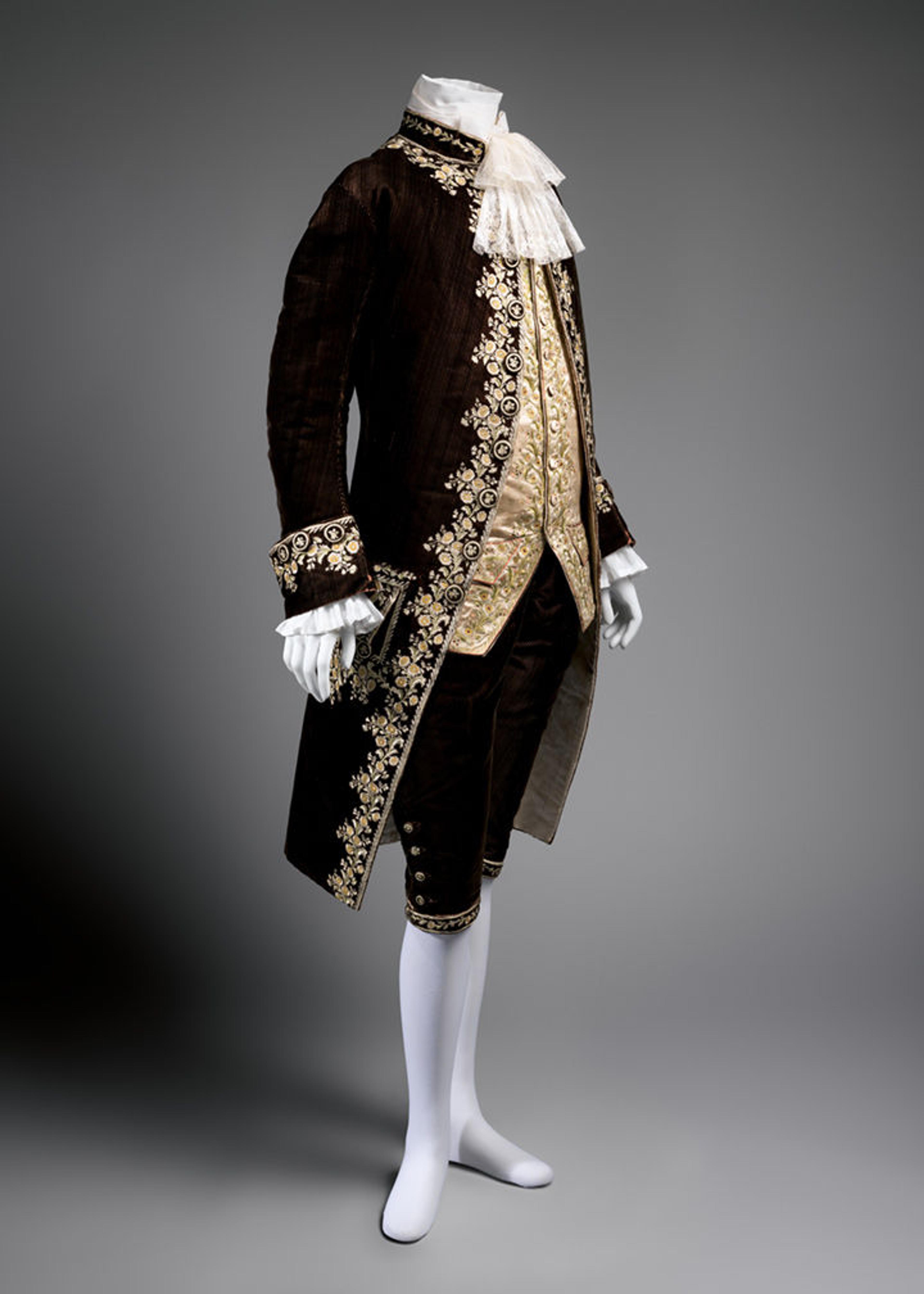
Court suit, 1774–93. French. Silk. The Metropolitan Museum of Art, New York, Purchase, Rogers Fund, 1932 (32.40a–c)
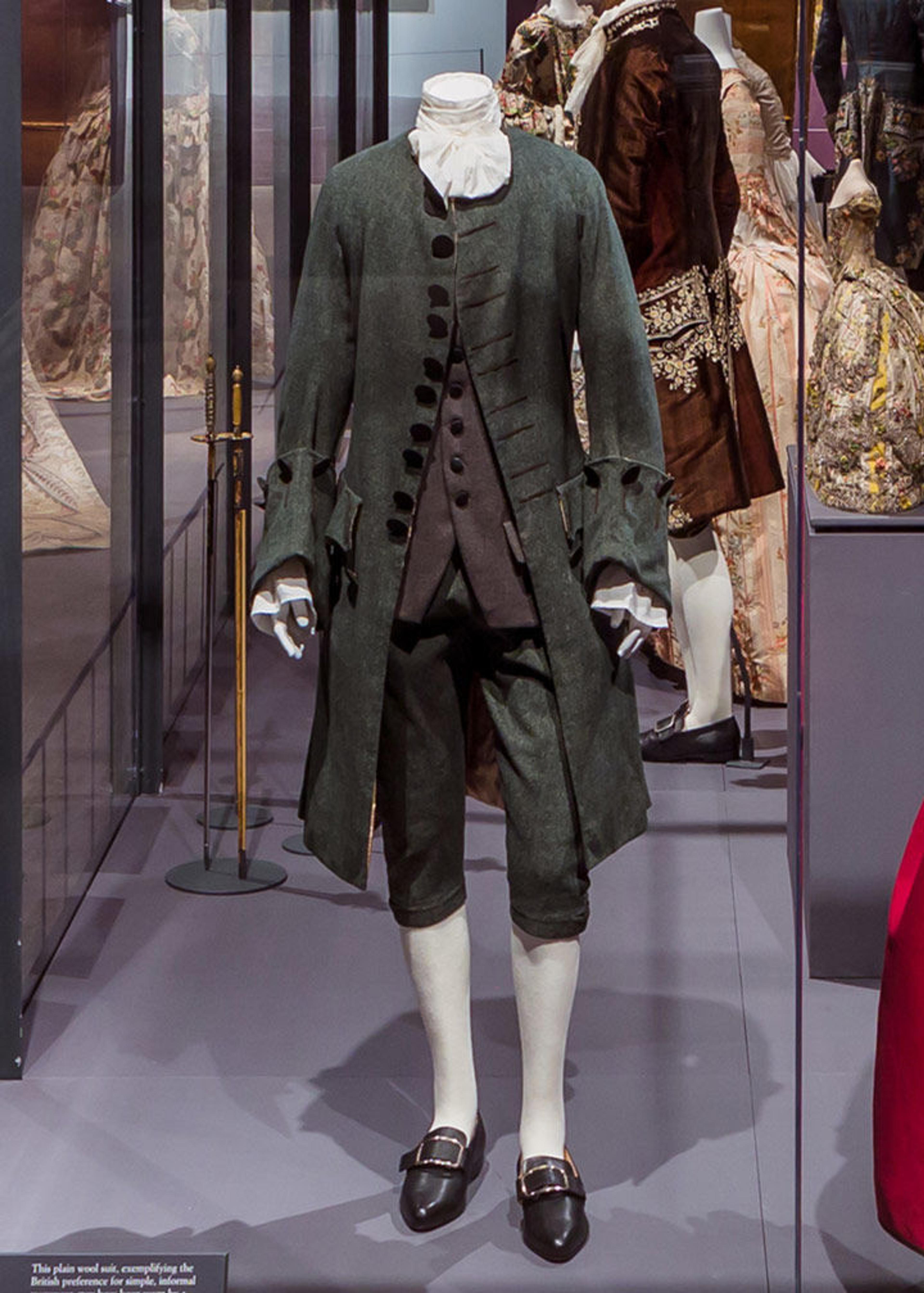
Suit, 1755–65. British. Wool, silk. Brooklyn Museum Costume Collection at The Metropolitan Museum of Art, Gift of the Brooklyn Museum, 2009; H. Randolph Lever Fund, 1968 (2009.300.916a, b)
It's common for ensembles dating from more than two hundred years ago to have lost some of their elements before coming into the Museum's collection. Showing incomplete ensembles can be distracting to the viewers, as well as inaccurate, so we often complete the total look with non-accessioned accessories, either antiques or made new. For example, our British man's traveling suit consists only of a frock coat and breeches, but the Museum's curators decided that the gentleman would also have worn a waistcoat. Joyce Fung, the Costume Institute's Senior Research Associate for Installation, sewed a new one, based on a historical pattern, using a heathered-wool fabric (sourced from New York City's garment district) that closely matched the color and texture of the original. Additional items were added for the installation, including a vintage cravat and cuffs, and reproduction shoes and stockings.

Left: Costume Institute Conservation Fellow Marina Hays pins in the reproduction stomacher she made for the robe à la française. Photo by Cassandra Gero. Right: During treatment of the skirt on the robe à la française, laid and couching stitches with fine silk thread and a new backing fabric are used to stabilize the damaged area. Photo by Marina Hays. Robe à la française (details), 1775–1800. French. Silk. The Metropolitan Museum of Art, New York, Purchase, Irene Lewisohn Bequest, 1961 (C.I.61.13.1a, b)
The robe à la française was missing its stomacher—the triangular piece of fabric used to close the bodice of a gown—a common problem for eighteenth-century gowns in museum collections. To complete the gown's authentic look, Marina designed and created a reproduction stomacher based on her research into extant objects and printed images from the time. She sourced an appropriate silk fabric and painted it to match the dress fabric; and she used silk floss to create fly-fringe trim that matched the original style of trim used on the dress. Creating fly fringe was a painstaking task for Marina but was apparently a popular pastime among ladies over two hundred years ago!
Displaying costume accurately and beautifully requires more than recreating missing elements: conservators must also achieve the garments' correct shape. To fill out the wide, flat shape of the robe à la française's skirt, Marina used reproduction panniers from our stash of dressing supplies to create a support of the correct size and shape. Stiff buckram, structured in a cone-like shape around the mannequin's torso, mimics the look of stays, the eighteenth-century version of a corset. The silhouette of the robe à l'anglaise is less dramatic, but the skirt still needed a couple of cotton petticoats to achieve the right fullness.
Mannequins must be adjusted not only to the bust, waist, and hip measurements of the garment, but also to the correct height so that the hemline falls at the proper placement. The rules of fashion were very strict back then! In the 1780s, the skirt length for informal gowns would have been high enough to show the wearer's feet, so our mannequin needed shoes. After all, one cannot stroll barefoot through the gardens of Versailles! We chose a pair of silk shoes from the Museum's collection, but buckles were separate from shoes back then, and our shoes had no closures. Marina worked with Associate Curator Jessica Regan to determine the shape and size of the buckles that would have been worn.

Attributed to Marie-Jeanne "Rose" Bertin (French, 1747–1813). Formal ball gown (robe parée), 1780s (with later alterations). French. Silk satin, with silk embroidery, appliqués of satin; metallic threads, chenille, sequins, applied glass paste; 84 5/8 x 41 3/4 in. (215 x 106 cm). Royal Ontario Museum, Toronto (925.18.3.A–B)
Although the Costume Institute has a magnificent collection of eighteenth-century costume, Daniëlle Kisluk-Grosheide and Bertrand Rondot, the curators of Visitors to Versailles, also borrowed significant objects from other lenders, such as the Kyoto Costume Institute, the Smithsonian Institution, the Nordic Museum, and even the Palace of Versailles itself. However, lending a costume is not as simple as lending something like a vase or a painting. Clothing is often stored and shipped flat, requiring the courier (the lending museum's representative, who accompanies the artwork to ensure its safety) to dress garments on-site at The Met. Thus, before the loans arrived, the Costume Institute conservation and installation teams worked with our lenders to confirm the size of their garments and to ensure that we had appropriate mannequins and dress forms on hand that would both fit their objects and create the desired fashion silhouette. In some cases, the Costume Institute helped the couriers dress their objects, working with them to choose appropriate styling props, such as the engageantes that completed the look for the Royal Ontario Museum's formal ball gown (robe pareé), which may well have belonged to Queen Marie Antoinette!
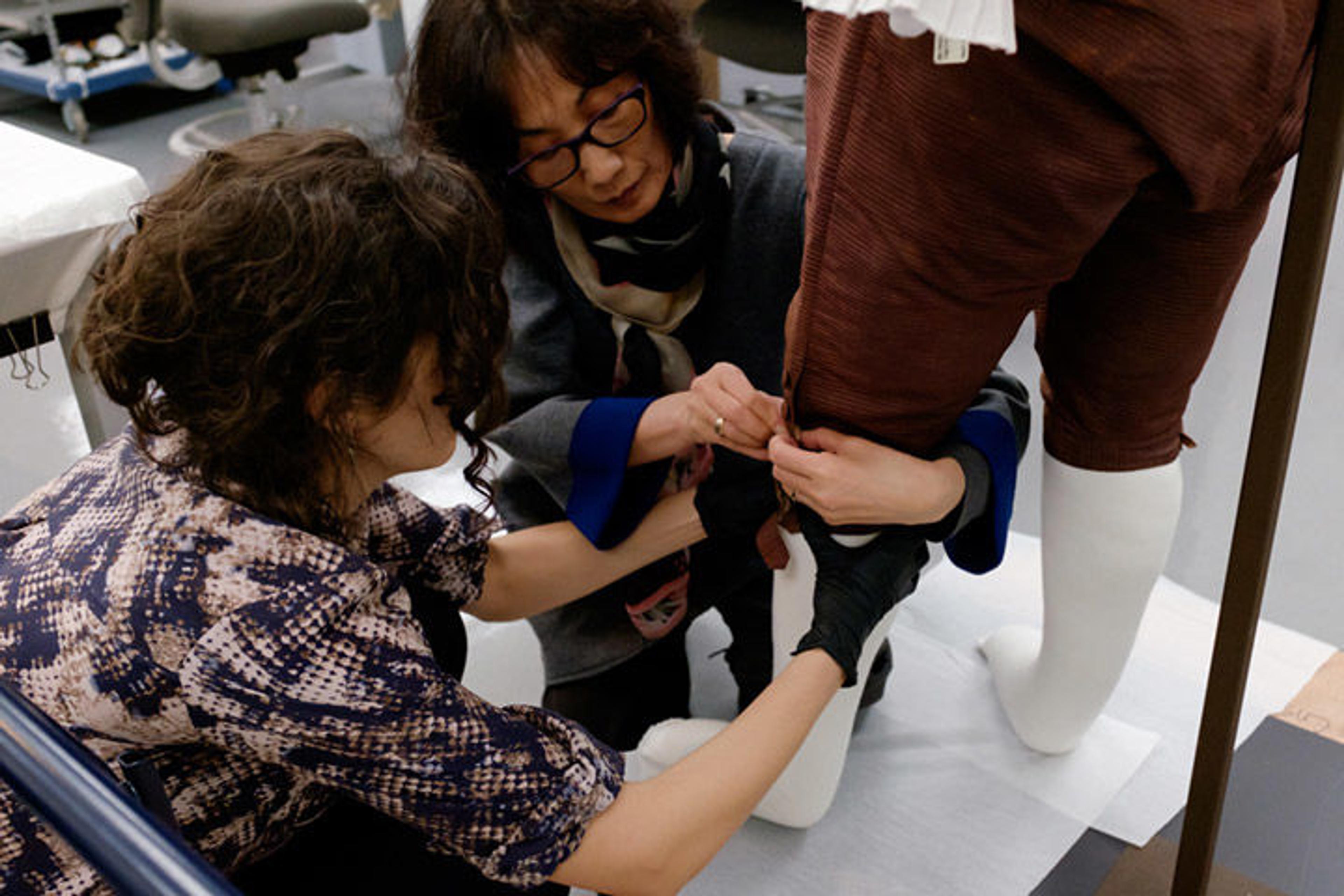
Sarah Scaturro, head conservator at the Costume Institute (left), and Sunae Park Evans, senior costume conservator at the Smithsonian's National Museum of American History (right), dress the mannequin with Benjamin Franklin's suit.
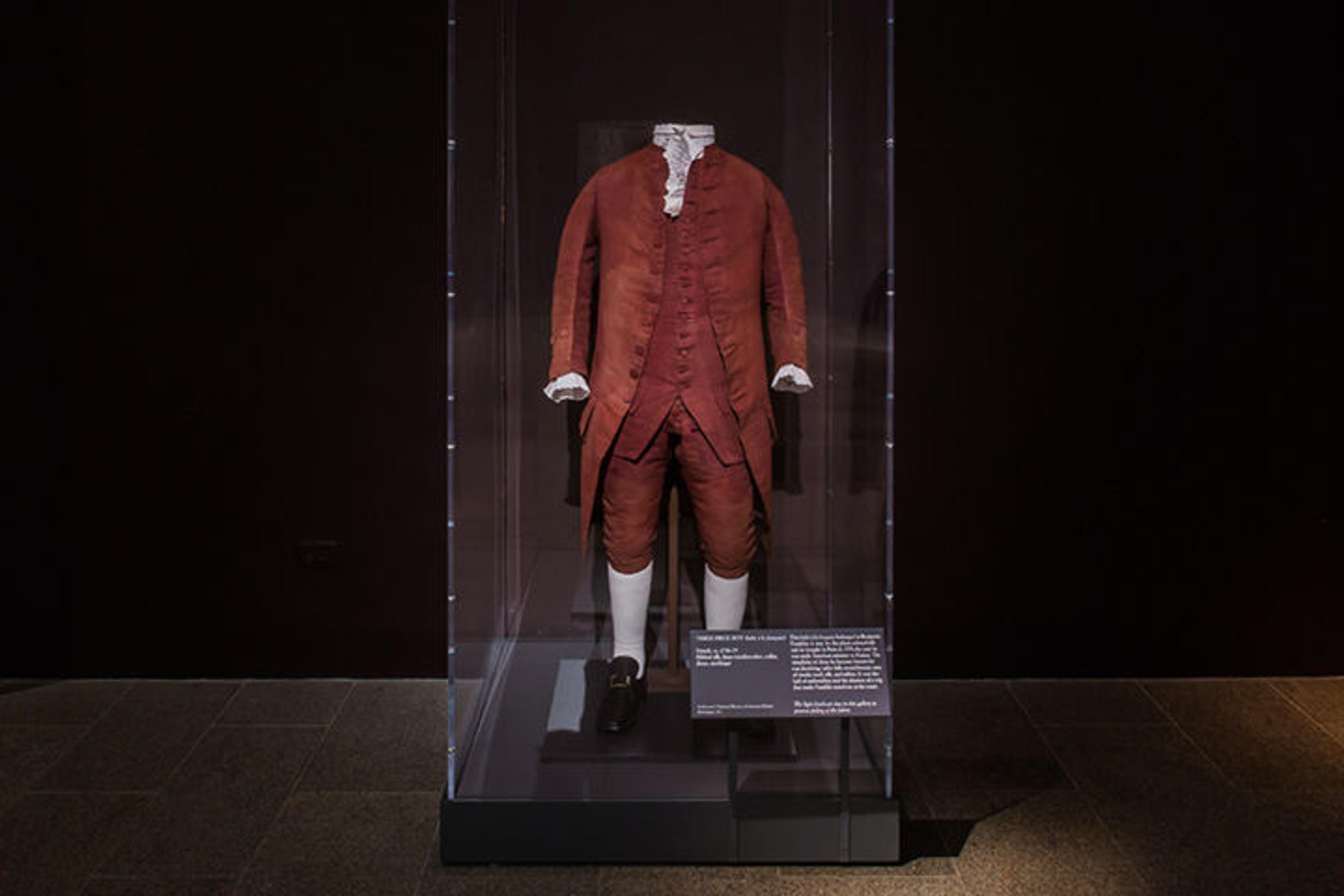
Three-piece suit (habit à la française), ca. 1778–79. French. Ribbed silk and linen (reproduction shirt, shoes, and stockings), 60 x 30 x 24 in. (152.4 x 76.2 x 61 cm). Smithsonian's National Museum of American History, Washington, D.C. (2012.0187.001)
Perhaps the most iconic ensemble in the exhibition is the plum-silk three-piece suit worn by Benjamin Franklin to the signing of the Treaty of Amity, which is currently in the collection of the Smithsonian's National Museum of American History. Purchased by Franklin in France in 1779, the suit was the height of elegance while also reflecting the sober democratic ideals of the newly created American Republic through its spare surface embellishment. This suit is such a rare and important garment that it is almost never displayed, due to conservation concerns.
In the spirit of true collaboration, Costume Institute Conservators Sarah Scaturro and Christopher Mazza worked with Met scientists Nobuko Shibayama and Federico Carò, and National Museum of American History Senior Costume Conservator Sunae Park Evans to carry out analytical testing on the suit to determine both the kind of dye that was used and its sensitivity to light. The results Nobuko and Federico gleaned from liquid chromatography with photo-diode array detection (HPLC-PDA) and scanning electron microscopy-energy dispersive x-ray spectrometry (SEM-EDS) revealed that the suit was dyed with logwood (a soluble redwood dye made, for example, from brazilwood), and young fustic, with alum likely as the mordant—all dyes consistent with late eighteenth-century European luxury-textile production.

Research Scientist Nobuko Shibayama (left), Conservation Assistant Christopher Mazza (right), and Sarah Scaturro (rear) perform a microfading test on Benjamin Franklin's suit.
The team also carried out microfading analysis, an analytical technique that compares the rate of fading induced on the object in an area less than .3 millimeters wide (about the size of the tip of a pin) to known rates of fading for textiles. The results of this test indicated that the dye is indeed light sensitive, so the suit must always be displayed under low light levels and with great care. What our visitors may not notice is that the Museum's excellent lighting team has established the lighting levels throughout the exhibition galleries so that they lower gradually. By the time Franklin's suit comes into view, visitors' eyes have adjusted to the very low light levels that ensure the suit's preservation.
Besides conservation treatments, scientific testing, and fashionable styling, the biggest costume challenge was logistical: finding the space to temporarily mount and store these huge gowns. The Museum's Registrar and Exhibition offices worked closely with the Costume Institute team and the lenders to make sure that the installation went smoothly. Once all of the objects and their couriers had arrived, we took over the area that is now the exhibition's retail shop, creating a satellite lab that could accommodate important conservation processes, such as condition reporting and dressing.
Even more challenging was choreographing the installation of the huge costume case that greets all of our visitors—before the case could be closed, every single lender had to be present, along with the Costume Institute's conservation and installation teams, other conservators from around the Museum who were helping with the doll and the weapons, the curators, and all of the other people who make our exhibitions such a success—the project managers, registrars, mount makers, riggers, technicians, and more. As our ace plexiglass team—which is responsible for closing and opening all vitrines throughout the Museum—put the last plexiglass panel into place, we all breathed a sigh of relief and stood back to marvel at the glorious ensembles parading before us.
Related Content
Visitors to Versailles (1682–1789) is on view at The Met Fifth Avenue through July 29, 2018.
Learn more about the binaural audio experience and view the exhibition galleries.
Learn more about Visitors to Versailles in a blog series published in conjunction with the exhibition.
The exhibition catalogue is available for purchase at The Met Store.
Sarah Scaturro
Conservator Sarah Scaturro is in charge of The Costume Institute's conservation laboratory and the preservation of the collection. She was previously the textile conservator and assistant curator of fashion at the Cooper-Hewitt, Smithsonian Design Museum. Most recently, Sarah co-authored "Inherent Vice" in Charles James: Beyond Fashion (2014), and was the guest editor for the special issue on "Curating Costume/Exhibiting Fashion" for the Journal of Fashion, Style and Popular Culture. She received an MA in fashion and textile studies from the Fashion Institute of Technology; a BA in history and Italian from the University of Colorado, Boulder; and is currently pursuing a PhD at Bard Graduate Center.
Cassandra Gero
Cassandra Gero is an assistant conservator in The Costume Institute.